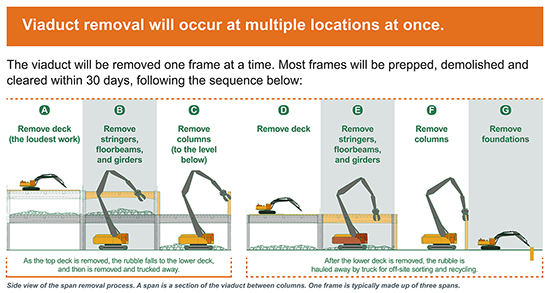|
Subscribe / Renew |
|
|
Contact Us |
|
| ► Subscribe to our Free Weekly Newsletter | |
| home | Welcome, sign in or click here to subscribe. | login |
Construction
| |
December 5, 2018
Kiewit lays out viaduct demo job
Journal Construction Editor
Kiewit Infrastructure West Co. and the Washington State Department of Transportation briefed the press yesterday on how the Alaskan Way Viaduct will come down after the state Route 99 waterfront tunnel opens in February.
Kiewit won a $93.7 million design-build contract to remove the 1.4-mile viaduct, decommission the Battery Street Tunnel and connect roads at the tunnel's north portal.
Brian Nielsen, Alaskan Way Viaduct Replacement Program administrator for WSDOT, said crews will take a “methodical approach,” and focus on protecting people and property. That means lots of Jersey barriers and fencing around the work zone, and heavy nets to catch debris.
There also will be monitors to make sure that noise and vibration stay within limits.
Nielsen said the work will be similar to removing the southern mile of viaduct six years ago, but this job will be complicated by some buildings that are just an arm's length from the viaduct.
WSDOT wants to have the central waterfront portion of the viaduct gone by June, the unofficial start of tourist season. The entire viaduct should be gone by August. Nielsen said waterfront businesses will remain open during demolition.
Phil Wallace, Kiewit's senior operations manager, said initial work will focus on taking down the Columbia Street viaduct on-ramp so that the city can proceed with making Columbia into a two-way bus corridor from Third Avenue to Alaskan Way. He said it will probably take three weeks to remove the ramp and a section of the viaduct connected to it.
Crews also will remove the Seneca Street off-ramp to the north. That should take about two weeks, according to Wallace.
While one crew is working on the Columbia ramp, three other crews will start work on the northern section of the viaduct. Initial work there will involve saw-cutting concrete near railroad tracks.
Kiewit's schedule shows one crew removing the viaduct between the Battery Street Tunnel and Lenora Street in February and March; the second crew removing the section between Blanchard and Stewart streets from February to July; and the third crew removing the section between Pike and Virginia streets in February and March.
Removal work along the central waterfront — from Columbia to Pike streets — will start in March and continue to June.
The rest of the viaduct, from Cherry Street to near CenturyLink Field, will be demolished from March to August.
Nielsen said crews will work on three-span sections at a time because the viaduct is a series of three-span bridges that are independent of one another.
Kiewit estimates a span can be prepped, demolished and removed within 30 days.
Demolishing a span will go something like this:
• Fence area and finish prep work and staging
• Remove top roadway deck with impact hammers
• Remove girders and columns supporting the upper deck using high-reach excavators with demolition claws
• Remove lower deck with impact hammers
• Remove lower girders and columns supporting the lower deck
• Remove foundations and restore the site
A different process will be used for the on- and off-ramps. For that, crews will use small excavators to remove the decks, and then forklifts and cranes to remove girders one-by-one.
Kiewit will also build a temporary pedestrian bridge to replace part of the Marion Street pedestrian bridge that crosses under the lower deck of the viaduct. The bridge will take up to four months to build and will connect to the existing bridge at Western Avenue. It will turn at Columbia Street and span the Alaskan Way surface street to reach the Colman Dock ferry terminal.
WSDOT says there may be a gap of up to 14 days between closing the existing pedestrian bridge and opening the temporary one.
A permanent bridge is expected to open as part of the $373 million Colman Dock rebuild that is due to finish in early 2023.
Kiewit's demolition subcontractor, California-based Ferma, will pulverize concrete from the viaduct into 3-inch-diameter chunks and use them to partially fill the Battery Street Tunnel. About 7 feet of space between the rubble and the tunnel ceiling will be filled with low-density cellular concrete that will be pumped in from surface vents along Battery Street.
WSDOT plans to close the viaduct on Jan. 11, and take about three weeks to connect SR 99 into the new tunnel.
Nielsen said the closure will have a regional impact on traffic. About 90,000 people travel on the viaduct during week days.
Benjamin Minnick can be
reached by email or by phone
at (206) 622-8272.



